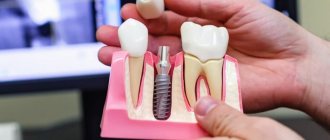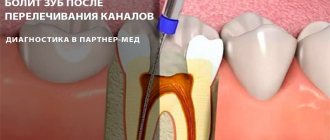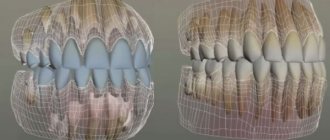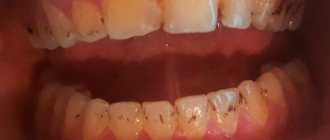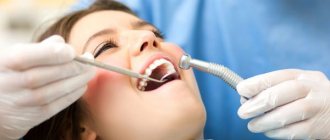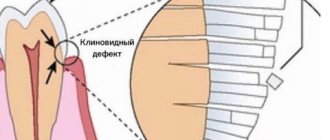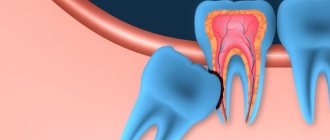A tooth overgrown with gum is a fairly common occurrence. Basically, this situation occurs when the crown breaks off completely, is not subjected to dental treatment, and tissue grows on it. If at first the problem may not bother you, then after a certain period it may develop into an inflammatory process, resulting in damage to neighboring teeth.
Indications
Experts highlight the following series of main indications:
- Tooth fractures of various etiologies.
- Development of inflammatory processes.
- Loss of tooth integrity (it fell apart, broke, rotted).
- Third level of root mobility.
- Abnormal locations of decayed teeth.
- Manifestation of characteristic symptoms of inflammation.
Important! Extraction of the root of a tooth that has collapsed is a mandatory procedure. It is the main breeding ground for infection in the oral cavity. The presence of rotten roots at the top provokes the formation of granulomas and cysts, which can subsequently develop into a malignant tumor.
Preparing for removal
Remaining tooth root.
At this stage the following is carried out:
- A complete examination of the oral cavity and especially the area with the remaining root. A panoramic photograph of the jaw is taken, and the soft periodontal tissues are checked for the presence of inflammatory processes and suppuration.
- The doctor draws up a treatment plan.
- A suitable painkiller is selected.
- The entire set of sterile instruments is prepared.
- Hygienic treatment of the oral cavity. If necessary, plaque and tartar are removed.
- The mouth is rinsed with a solution of chlorhexidine or eludril.
- The gums are numbed.
- If indicated, an incision is made in the gums followed by extraction of the tooth root.
Reference! Correct and complete preparation for the operation is the key to its successful implementation, and to eliminating the subsequent development of complications.
What problems can non-removed roots create?
Problems arising from inflammation of the tooth root are in some cases solved by removing it
- Suppuration. An untreated root is where bacteria accumulate. Over time, inflammation and suppuration may begin there. The longer the root is in the gum, the more purulent exudate accumulates in it. The tooth begins to hurt, and the infection spreads to other tissues
- Decreased immunity. Even one bad tooth can negatively affect the functioning of the immune system. If it is not treated or removed, bacteria will begin to accumulate in the cavity, causing inflammation. This inflammation spreads through the bloodstream throughout the body, reducing its ability to resist disease. Therefore, it is important to treat teeth in a timely manner and also pull out damaged roots.
- Gum diseases. If you don't get rid of the tooth root, it can cause gum disease. As a result of the chronic inflammatory process, the bone tissue gradually begins to dissolve, and a cyst develops inside the gum
- Flux. Very often, destroyed tooth roots left in the gum become inflamed, then the inflammation spreads to neighboring tissues, causing gumboil. Under the influence of pathogenic bacteria, pus accumulates inside the gums. There is more and more of it. The cheek swells, severe pain occurs, and body temperature rises. This condition requires immediate medical intervention.
Tools: forceps, drill, elevators
| Name | Process description | Application |
| Forceps | With their help, a part of the tooth is taken that protrudes on both sides above the edge of the alveolus. To do this, it is first necessary to separate the periodontium from the root surface or peel off the mucous membrane from the boundaries of the alveoli. | To carry out manipulations on the paired jaw, a tool with straight ends is used. Forceps with wide bayonet-shaped blades are used to remove the roots of any teeth located on the upper jaw. The lower jaw is processed using wedge-shaped forceps. |
| Elevator | The initial stage of surgical resolution is carried out by performing a syndesmotomy. Afterwards, an elevator is inserted into the cavity between the walls of the periodontal socket and the root body itself. One of the main indications for its use is the deep location of the root in the alveolus, which makes it impossible to extract it with forceps. | Roots in the upper jaw that are abnormally located outside the dentition or are a hidden part of the third molar in the lower jaw are removed using a direct elevator. The roots of the teeth in the lower jaw are removed using an angular elevator. A Lecluse elevator with a peaked working part is used to remove the third large lower molar. |
| Drill | It involves removing the outer wall of the alveoli with a bur, followed by extracting the root with forceps. | It is used only for removing the root of a single-rooted tooth or if the roots of a multi-rooted tooth are located separately. This method is indispensable for extracting the root after a fracture of its apical section, significant curvature, hypercementosis, or abnormalities in shape and position. The drill is also used when the root is located deep in the alveolar process, or when it is completely covered with bone tissue and mucous membrane. |
Forceps Elevators Drill
Removing a tooth root is a complex dental procedure that requires high professionalism from a dental surgeon. The correct choice of tools for its extraction is the key to a successful operation.
Fixed dentures supported by your teeth
- When to place: if 1-4 teeth are missing in a row, and at least 1 healthy tooth or root should be preserved on each edge of the “empty” space. We are talking about dental bridges or bridge-like prostheses.
- Wearing period: in most cases, this is a permanent fixed prosthesis, so such a prosthesis will last approximately 5-7 years.
The most popular method of prosthetics after root removal is a bridge structure or, more simply, a dental bridge. These are several artificial crowns connected in a row. Moreover, the central ones replace missing natural crowns (there are no roots under them), and the outer ones are fixed on natural teeth or their roots. That is, in order to restore 1 extracted tooth, you need to use two adjacent ones for support. Which does not have a very good effect on their service life. After all, the supports need to be sharpened, the “nerves” (neurovascular bundles) removed from them - so they receive less useful substances in the future.
There is a temporary version of the bridge structure - this is an adhesive bridge. It does not have end crowns, but instead there are plates or “wings” on the sides of the artificial crown that are glued to the abutments on one side. However, the fixing composition and shape of the fasteners cannot provide a reliable connection for many years. Therefore, adhesive bridges often come off when chewing.
The advantage of bridges is that they are highly aesthetically pleasing – especially those made, for example, from E.max ceramics from Ivoclar Vivadent, glass ceramics from VITA Zahnfabrik or Prettau zirconia. Metal-ceramic crowns during operation reduce the aesthetics of a smile, because... may cause “blueness” of the gums. If you choose metal ceramics, it is better to give preference to quality brands. For example, IPS Classic from Ivoclar Vivadent, Duceram from Dentsply Sirona, and Kuraray Noritake.
Extraction methods
In dental practice, the following methods are used to remove a tooth root:
- Hemisection. Used primarily on mandibular molars. The diseased root and the crown that is adjacent to it, or the part of the tooth located on top, are removed. The next stage of the procedure will be filling the roots and teeth. This technique eliminates the development of pathologies.
- Amputation. Used when surgical intervention on the upper jaw is necessary. Initially, the visible area of the periodontium is separated, the root is cut off with a drill and removed from the alveoli using forceps. The manipulation ends with filling the hole with osteo-replacing material.
- Cystectomy. Involves excision of the cyst on the root of the tooth. The procedure begins with the process of opening the upper part of the root. After removing the tumor, the freed space is filled with medical grade material.
All modern methods for removing tooth roots are carried out using local anesthetics. This avoids painful sensations.
Diagnosis of root caries
During a visual examination, dental root caries can be detected only in 13% of cases. If this disease is suspected, additional examination methods are prescribed:
- Probing. The doctor inserts an instrument with a curved tip under the gum and examines the structure of the tooth root, assessing its integrity. During such a study, it is possible to identify chips, roughness, and irregularities that indicate the development of pathology.
- Radiography. The dentist orders an x-ray of one tooth or the entire jaw. The images show the localization of the pathological area with an accuracy of up to a millimeter. In addition, radiography allows you to assess the condition of neighboring teeth and identify hidden inflammatory processes.
- Thermal diagnostics. The study is carried out using a directed stream of water, which is used to treat the tooth from different sides. After such a procedure, it is possible to determine which areas of the root are susceptible to carious lesions.
- Electroodontometry is a diagnostic of pulp viability, allowing you to find out whether the nerve is damaged and how deep the inflammation has penetrated.
- Visiography. Using a special device called a visiograph, the dentist scans the tooth in different projections. He can then view the root from different angles on a computer.
Before treating the root of a tooth, the dentist suggests the patient undergo ultrasonic cleaning to clean the enamel of plaque. Tartar may obstruct your view during the procedure. Based on the results of the examination, the doctor determines whether the tooth can be saved or whether it needs to be removed.
Further processing of the alveoli
Normally, a blood clot should form in the socket.
After root extraction, careful treatment of the alveoli is a mandatory rule. For these purposes, the hole is washed with special antiseptics, followed by the application of special anti-inflammatory drugs to the wound.
They are used not only for therapeutic purposes, but also for preventive purposes, despite the presence of an inflammatory process in the socket.
Their use promotes faster healing of the wound and prevents the development of inflammation.
Procedure
The complexity of the procedure directly depends on the specific case.
The simplest option looks like this:
- preparing the damaged area;
- anesthesia;
- deletion.
If the patient comes in with severe pain and flux, everything can be much more complicated.
It is difficult to perform an operation at a time of severe pain, because the procedure, even under anesthesia, will bring pain to the patient. In such cases, they often act differently. Initially, the pus is cleaned by cutting the gums, and after a few days, when the inflammation subsides, the root is removed.
Features of tooth root extraction in different jaws
There are slight differences in the methods and types of instruments used for manipulation on different jaws.
On the top, bayonet-shaped forceps are used to extract molars. C-shaped dental pliers are used to extract incisors and canines. For these purposes, rotational movements are carried out with pliers, which ensures minimal damage to the periodontal tissues. If it is impossible to extract the tooth root with dental pliers, then a drill is used.
The rejected root is removed after preliminary sawing the bottom of the tooth cavity. After using a drill with a ball-shaped tip, the necessary cavity is created in the inter-root commissure for longitudinal sawing of the bottom of the tooth with a furssor drill. Next, in the prepared cavity, using an elevator and bayonet-shaped dental pliers, the palatal root is dislocated.
The procedure for removing roots on the lower jaw is much simpler. For these purposes, as a rule, dental pliers with curves along the edge and with thin and narrow cheeks are used. Extraction of the roots of wisdom teeth is carried out by surgeons with the additional use of an elevator.
What to do after deletion
After any surgical intervention, you should follow all the dentist’s recommendations, as well as:
- do not eat for 2 hours after the procedure;
- cool the soft tissues of the face in the projection of the removed root;
- stop smoking for two days;
- take prescribed pain medication;
- make antiseptic applications;
- watch to see if other teeth are crumbling.
Sometimes after complex extractions, dentists prescribe antibiotics to patients. This appointment cannot be ignored - after a tooth is pulled out of the socket, a focus of infection forms in it, which can only be extinguished with the help of medications.
The following video schematically shows different methods for removing incisors, canines, molars and premolars of the lower and upper jaw.
Complications
Flux is one of the complications after tooth extraction.
The manipulation of tooth root extraction is quite traumatic and complex. Therefore, often due to the physiological characteristics of the body, or the unprofessional actions of the surgeon, the following difficulties may arise after this manipulation:
- Infection of nearby teeth and soft tissues.
- Spread of inflammation to the ligamentous apparatus with gums and teeth.
- Chronic inflammation will provoke the development of periodontal disease and other dental pathologies.
- Formation of flux, phlegmon or cyst.
- Severe pain that can last for several days.
- Swelling and inflammation of the soft tissues of the periodontium and face.
- Manifestation of pain when swallowing.
- Problematic mouth opening.
- Rapid increase in body temperature.
- Bleeding gums.
- Suppuration of the alveoli.
- Loss of sensation in the jaw area.
Attention! If you experience the slightest signs of inflammation after tooth root extraction, you should immediately visit a doctor to correct the therapeutic course and prevent the development of serious complications.
How to care for a restored tooth?
Recommendations from dentists regarding the safety of restored teeth are as follows:
- give up too hard foods (raw carrots, cucumbers, hard apples), the habit of gnawing seeds and nuts;
- limit or exclude coffee, tea, red wine, which contribute to the darkening of materials;
- quit smoking;
- brush your teeth regularly;
- avoid jaw injuries.
Important!
A tooth created from artificial materials needs the same care as a living one. In addition, it is advisable to regularly visit the dentist to prevent and prevent depressurization at the edge of the crown, as well as to have your teeth professionally cleaned.
+1
How painful is the manipulation?
High-quality anesthesia makes the procedure painless.
Many patients are interested in whether it hurts to pull out the roots of teeth? The duration of the operation depends on the clinical picture of the condition of the tooth and the root itself. Its location also plays a significant role. On average, with the high professionalism of the dental surgeon, such an operation lasts for half an hour. But, if a complex wisdom tooth root extraction is carried out, then such manipulation may take 90 minutes or more.
In modern dentistry, when extracting a tooth root, strong anesthetic drugs are used, under the influence of which pain is not felt at all. They are selected for any pain threshold. The effect of such drugs is sufficient not only for the operation itself, but also for two hours after it. Also, depending on the complexity of the manipulation, general anesthesia may be performed.
Important! The selection of anesthesia should be carried out exclusively by a doctor, taking into account the patient’s health status and age category, as well as the complexity of the operation.
Postoperative period
After the dentist removes the remaining fragment, you must strictly follow all his recommendations. Usually the doctor prescribes for the entire postoperative period:
- taking broad-spectrum antibiotics to relieve inflammation (up to 7-10 days);
- rinses and baths with solutions that disinfect the oral cavity - Miramistin, Chlorhexidine or infusions of medicinal herbs (chamomile, oak bark, sage);
- painkillers.
It is also very important after surgery:
- do not take any food for 3-4 hours;
- You are allowed to drink only after 1.5-2 hours, and only plain (without gases) water;
- do not chew on the side on which the operation was performed;
- for the first 24 hours, do not brush your teeth, but only rinse your mouth (not intensively!);
- apply cold to the cheek to reduce swelling (on the first day every half hour for 15-20 minutes);
- exclude spicy, sour, very hot, hard, viscous foods from the diet for the entire postoperative period;
- do not touch the hole with your finger, tongue, or toothpick;
- you need to avoid physical activity and sports;
- do not drink alcoholic beverages and, if possible, do not smoke.
Important! It is impossible to warm up (apply a warm compress) - this is dangerous due to the appearance of secondary inflammation. You also cannot visit the sauna, bathhouse or sunbathe on the beach on a hot day.
The condition is considered normal if the temperature rises slightly in the first days (no more than 37.5⁰C), discomfort and minor pain persist.
Let's find out together whether the temperature can rise after tooth extraction, and what medications are best to take.
In this article we will tell you whether the hood over a wisdom tooth needs to be removed.
Here https://www.vash-dentist.ru/lechenie/zubyi/lz-mudrosti/udalenie-retinirovannogo.html read about the stages of removing an impacted tooth.
Root removal at home
Tooth root removal is a complex dental operation; it is prohibited to perform it at home!
Despite the availability of modern techniques for extracting tooth roots, many people are terrified of this procedure. Therefore, some of them decide to carry out this manipulation on their own at home.
For these purposes they manage to use pliers. Using forceps, people try to grab the base of the root and thereby remove it.
Naturally, such a resolution of dental pathology is unacceptable and unacceptable, since it poses a significant threat to health:
- The wound becomes infected, which can lead to the development of sepsis.
- Traumatic shock and stress shock are formed.
- It is impossible to completely remove it. The fragments remaining in the wound rot, which contributes to the development of additional dental diseases.
- High probability of developing serious complications.
- Extensive bleeding may occur.
Attention! If it is necessary to extract the root of a tooth, it is strictly forbidden to carry out the operation yourself, but you should immediately visit a dental clinic.
Symptoms
You can suspect that a tooth fragment remains in the gum after extraction based on the following symptoms:
- redness in the operated area that does not go away for a long time;
- temperature increase 3-4 days after manipulation;
- aching joints;
- chills;
- the appearance of an unpleasant odor;
- discharge of pus from the hole;
- pain that occurs even at rest;
- persistent swelling.
Some of these symptoms are the body's normal reaction to surgery - pain, bleeding, swelling, and redness. But they should not appear for more than 3-5 days, and every day their severity should subside.
If this does not happen, but on the contrary, the severity only intensifies, and new symptoms are added to it, we can confidently talk about a complication during the manipulation.
Important! You cannot examine the wound yourself for the presence of a fragment. Such an action can lead to infection, displacement or deepening of the fragment.
Expert opinions about tooth hemisection - is it a reliable restoration or a waste of money.
Read here about the indications for complex wisdom tooth removal.
At this address https://www.vash-dentist.ru/hirurgiya/udalenie-zubov/pezohirurgiya-bez-boli.html we will talk about piezosurgery in great detail.
What is special about molar root extraction?
Wisdom tooth root removal
Wisdom tooth root extraction is a complex and painful operation. This is due to its location, which runs along the longitudinal axis of the jaw. That is, molars grow across the roots of other teeth.
Therefore, molar root removal must be performed by a highly qualified surgeon. A prerequisite for this manipulation is radiography, and in some cases orthopantomography. The image will clearly show the location of the root in the gum.
Based on the diagnostic results, the doctor selects the most suitable method and tools for a successful operation. The duration of such manipulation is on average no more than one and a half hours. During this time the patient:
- A strong anesthesia is administered, and general anesthesia may also be required.
- Next, an incision is made into the gum tissue and the root of the tooth is extracted.
- After the alveolus is cleaned, it is treated with antiseptics and a special anti-inflammatory agent is applied to its cavity.
- If necessary, drainage is installed to drain purulent exudate.
- For deep periodontal incisions, sutures are applied.
Advice! To avoid the development of complications after molar root extraction, throughout the entire recovery period it is necessary to strictly follow all medical prescriptions and recommendations. You should also undergo a consultative examination on the third day.
Overgrowth of teeth by gums - the main reasons
- lack of dental treatment for a broken tooth;
- an insufficiently erupted wisdom tooth that is overgrown with tissue and puts pressure on the entire dentition. In this case, there is a high risk of misalignment and other orthodontic problems;
- patient's refusal to remove the root.
All of the above points lead to the fact that under the gum there is a destroyed part of the crown and root, which also brings a lot of problems to the patient.
The main reason why a tooth becomes overgrown with gum is a person’s neglectful attitude towards the condition of the oral cavity. Poor nutrition, bad habits, diseases, and insufficient hygiene lead to teeth becoming fragile, they are easy to break at the slightest pressure, and roots remain underneath them, which very quickly become overgrown with gum tissue.
Popular questions
- What are the features of the operation in the presence of overgrown periodontal tissue?
Tooth root overgrown with gums
The manipulation is carried out under general anesthesia by a surgeon in the presence of an anesthesiologist. First, gum resection is performed, opening access to the root and its canals. Afterwards, the root is extracted with a special instrument and the alveoli are treated with medication.
- What kind of doctor does this?
The surgical intervention is performed by a dental surgeon. If necessary, other specialists may be involved in a consultative examination.
- Do roots with caries need to be removed or treated?
The appropriateness of treatment for this pathology is determined by the dentist in each case individually based on the results of an x-ray examination. The main indication for extraction of the root of a tooth affected by caries is its damage by more than 50%. In other cases, treatment is carried out by installing an inlay and a special artificial crown.
- How to remove a cyst on the root of a tooth? Granuloma?
Removal of a cyst or granuloma is carried out through surgery. For this, depending on the indications, the following techniques are used: cystectomy, hemisection, cystotomy, laser extraction. In the presence of purulent exudate, after opening the granuloma, drainage is performed.
- Is it necessary to remove the roots of baby teeth?
It is not recommended to remove the roots of baby teeth. To carry out this manipulation, significant evidence is required. Experts include severe carious tooth decay, advanced stage of periodontitis, pulpitis or fistula on the gum, the formation of a cyst on the root of the tooth, as well as inflammation and rapid infection.
- What technique is used to extract a pin from a tooth root?
This manipulation is carried out using ultrasound. Under its influence, it is possible to carefully loosen the structure without damaging the natural tissues of the hidden part of the tooth.
- Why is my cheek swollen after this procedure?
The main reasons include: the complexity and high trauma of soft tissues during surgery; development of an inflammatory process or suppuration; unprofessional root extraction, the body’s reaction to certain medications; the appearance of a hematoma due to fragile capillaries.
- How is tooth root extraction done from the maxillary sinus?
First of all, perforation of its bottom is carried out, followed by endodontic treatment. Thanks to this technique, the hard tissues of the hidden part of the tooth are gently exposed during its extraction.
What to do if the gum grows on the tooth?
- do not wait until the process worsens, but quickly contact a professional dentist;
- the specialist will perform a visual examination of the tooth, send for an x-ray, ultrasound of the root to determine further actions;
- often overgrown and broken teeth are removed, but the gum tissue is first cut;
- if the tooth is healthy, after cutting the gum, the dentist installs a pin on top of which the dental crown is fixed;
- If the tooth cannot be saved, the root is extracted. The surgeon cuts the upper part of the tooth with an elevator (a special tool similar to a thin spatula), the root is grabbed with special dental forceps and gradually removed. The wound is then disinfected.
The operation to dissect the gums is carried out quickly, under local anesthesia, sometimes with sutures. After treatment, special preparations are applied to the wound to speed up the tissue healing process. A few weeks later, the surgeon examines the wound, removes the sutures and recommends a certain type of prosthetics or implantation to the patient.

